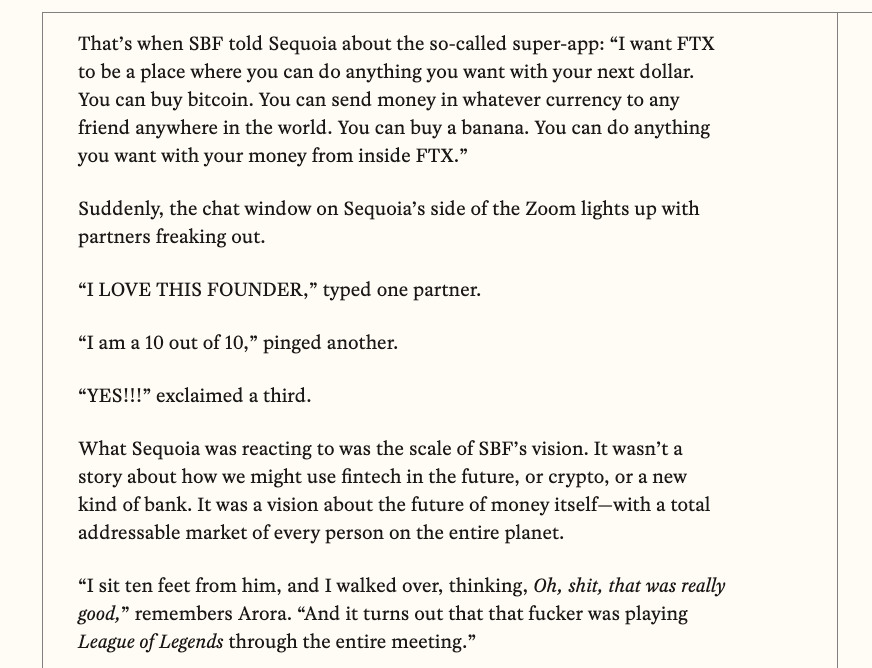A Shift to Liquidity

The mandate of Visary Capital moving forward is a continued prioritization and growth of liquid-focused strategies. Our ability to perform across crypto, public equities, private credit, and other digital asset and DeFi strategies has contributed to our outsized results and growth over the last 6 years. VC investments have always been a secondary focus and we now plan to further reduce the number of VC deals per quarter to around one (this includes and is largely dependent on follow-on investments). All of these investments will also be heavily benchmarked against liquid strategies.
The IRR of our VC-equity fund is around ~60.3%. Even though IRR is a core metric in VC, it is a flawed metric in terms of tracking real results, as it gives paper value a false mystique – and primarily a way to entertain LPs. Ours happens to be in the upper percentile among the VC asset class but we are thinking more about opportunity cost, optionality, and overall risk moving forward. We see the best opportunities in a variety of liquid strategies that both outperform this IRR and are truly priced, liquid, and realized (including factoring in the potential of QSBS and long term capital gains, the latter which we implement into liquid strategies anyway).
In parallel, we have also become more confident in our pattern recognition in VC, and believe that a combination of follow-on capital in our existing companies and less deals, but at the highest level of scrutiny, quality and slightly larger sizing, will outperform going wider and thinner (particularly when VC has become so noisy and overcrowded).
In markets, liquidity is king and staying nimble and having parts of the fund enabled to shift with market narratives, particularly in a crypto-focused fund, should supersede everything else. Many funds involved in the crypto space underperformed simply holding Bitcoin and Ethereum through the last cycle and they do not assess their performance against a crypto index.
Liquidity is also truth in markets, or at least the closest thing resembling it in the present. On average, the more liquidity and depth an asset has over a substantial period of time, the 'truer' the valuation is likely to be.
An example of liquidity’s importance in realistic asset pricing was FTX's balance sheet before their collapse. It was filled with low-grade, low-float crypto assets (SRM, SBR, MAPS, etc). On paper, these assets had massive fully diluted valuations that were faux-accounted at face value and even used for collateral (and accepted as such by lenders), but had almost no liquidity. Their FTT exchange token had the same characteristics (extremely high FDV <> very low liquidity), which should have been a telltale sign. This is ironically somewhat analogous to how VC holdings are being valued in the present, making things like IRR very unreliable – at least until secondaries are substantial to reference against.
Regarding FTX, these things should have been red flags for VCs if financial due diligence was actually being practiced but instead, we got these types of memos:

State of VC
There are certain VCs that raised $1B+ funds at the peak bull cycle and continue flooding the market with unwarranted valuations. Their asymmetric sizing in rounds attempts to make up for the smaller multiple likelihood. These rounds should be explicitly avoided by most for obvious reasons – but perhaps the lesser acknowledged is the psychological impact on a pre-product or pre-traction seed-stage founder suddenly having $20M+ in the bank (yes, some can handle it and in outlier cases, it can make sense). Some seed valuations have come back to "reasonable" levels with a focus on traction, and there are certainly some new deals we will push to fund. But even in this vintage where ~$10-12M seed valuations are becoming more common, it's harder to justify most when comparing against other opportunities. Sub-$10M caps can become more justifiable (every $1M means a lot at these lower valuation levels) but will always depend on exceptional founders regardless.
VC can certainly be an exciting game and it's easy to get addicted to the "what ifs" and the potential to change the technology landscape via one moonshot. As an asset class however, it has not outperformed markets at large since the mid-90s. Paper wealth and markups are often conflated with delivered, realized gains, which are rare. The other aspect of VC is that exits are rarely, if ever, clean. While straight cash acquisitions do happen, the majority of acquisitions are a mixture of cash and stock – and often stock priced at the richest possible valuation in the acquirer. The majority of IPOs and SPACs in tech have also not aged well and many were locked out to sell when 'things were good' or the stock price simply cratered to a previous Series' valuation. Many horror stories there. There are obvious exceptions to this but exits are rarely optimal, especially post-heavy dilution and on crowded cap tables and 'party rounds', which have increasingly been the case.
Our investment in Staked was perhaps an example of a near-ideal scenario in VC. They were acquired for a large multiple of the original raise, of which there was only one. A single, priced seed round was enough for the Staked team to grow into a very profitable business. This is how it should be more often but instead, we have multiple SAFEs, bridge rounds, and heavy dilution along the way. In general, the "$2M at ~$25M" range SAFE era is sure to age poorly in aggregate, with some exceptions. Many of those companies are stuck at major fundraising crossroads as we speak or have winded down. In our view, "Series Seed" should return swiftly to the market and a priced round and cap table should be as defined and transparent as soon as possible.
Many founders are also learning the hard way that paper wealth is fleeting. Many "up rounds" and high paper valuations that were euphoric in the moment are now realized to have been somewhat of a mirage. Aspects of this should improve in a post-ZIRP landscape, which is why we are certainly not writing off the asset class as a whole, but we have critical questions for every VC deal: Can this outperform various liquid strategies? And does it deserve to replace liquidity and optionality?
Illiquidity is a feature of VC that few can afford in reality, and most pretend they can afford. As of right now, there are dozens or hundreds of illiquid 'zombie' VCs that exist in the market. They've deployed the majority or all of their capital and are simply sitting on their hands daily waiting for something to happen. In most cases, there is very likely no substantial realized returns and they won't be able to raise another fund.
Our limited VC focus will primarily be on supporting, advising, and doing everything we can for our existing portfolio companies. Additionally, most capital reserved for VC will be in follow-on rounds and for pro-rata in existing investments. Despite the tone of this article, we still have many VC holdings we are very excited about and many of our portfolio companies have excellent prospects. Many of these investments were also made in less crowded circumstances and during better vintages (i.e. pre-2020).
New VC equity investments we make are likely to be in more 'boring' but profitable businesses or grander moonshot visions from founding teams we have the utmost confidence in. Nothing in the middle of that. All of this will still fall under the guidelines of our broad thesis, but more heavily scrutinized against internal benchmarks.
Above all else, we will only participate in new deals where we can help in a major, unique way on the sales, GTM, and/or product fronts. Large VCs don't necessarily need to think this way and spread capital much wider and in a less specialized way. For them, capital from LPs is mandated to be deployed, and LPs want to see that activity and be sold on hopes and dreams. This can become hard to scale, size, and manage.
Bottom line on VC: There are clearly exceptional returns to still be had in VC on a selective, one-off basis. As a basket, the asset is fairly broken. If you have deep access to find top talent early, can provide outsized/specialized support, AND you can focus on increasing ownership consistently with follow-on capital and have general leverage over a founders' cap table (which sounds a bit weird), then VC very well could make sense above all over assets. This represents <1% of funds. Too many are LARPing otherwise. Despite our "IRR" being upper percentile, that is not our north-star metric and we are seeing more opportunity in other strategies over the coming years.
A Note on 'Crypto VC'
Some in the market claim that 'crypto VC' solves the illiquidity conundrum since tokens often have a clearer, quicker window of launching and becoming liquid versus shares. Our firsthand experience through multiple cycles is this is half true. The data seems to point to crypto VCs outperforming traditional VCs on average – but it is unclear what % of that outperformance is from "venture" type deals within crypto versus certain, often old-school crypto-native funds (Polychain, Pantera, etc), having liquid funds that hold things like Bitcoin and Ethereum. Equity-based crypto investments aside from a few exits (e.g. Coinbase IPO, Staked exit) have been mostly disappointing due to less clear business models in the space outside of a few areas (i.e. exchanges, mining, staking). Token investments often depend on the stars aligning to match the market cyclicality of crypto, particularly with lockups and vest periods lining up. We know of many funds that became highly wealthy on paper during the last bull cycle but they were locked out until post-market crash – and often in projects that are unlikely to come back strong. In cases where lockups were not an issue, many also had issues not knowing when to sell and lock in some gains.
Many 'crypto and crypto-lite' VCs don't have a great understanding of managing liquid assets once they go live or how to buy/sell on the open market opportunistically. Many don't have a sell strategy in place and the vast majority are benchmarking gains in USD instead of in liquid crypto assets. In our view, every 'crypto VC' should at the very least benchmark performance against Bitcoin, if not a small basket of the most liquid and easily acquirable crypto assets (i.e. BTC/ETH and increasingly SOL this cycle).
Our 'crypto VC' investments made in ~2018/19, and some of the eventual 100% market exits in projects like Skale, Livepeer, and Filecoin offered very sizeable returns (greater than top percentile traditional VC returns and in a shorter time period), which also easily outperformed our in-house crypto benchmark of BTC and ETH. Assets we still hold like Stacks and Solana did the same, but have also been able to survive multiple market cycles and come back stronger – which has been our key question when assessing any potential VC-token bets. Very rarely do vest periods line up with the market cycle, and many crypto projects do not last more than one cycle due to the harsh nature of crypto cycles and the lack of long term plans, community, developers, etc. We managed to dodge most of those "single cycle" bullets.
Our investment in Lido last cycle is an example where staying nimble in crypto matters. Lido previously did a 'treasury diversification' deal (popular at the time) at various levels under and around $1 to various 'crypto VCs' with lock-up periods. Instead of participating in that, we bought Lido on the liquid market for around $0.48 – lower than the treasury offering, AND we were able to capture upside and had optionality to rotate. This is just one example of many. As of now, there are a number of live assets that VCs are marked up on, on paper, but the vest periods are another few years. Some of these actually fell below their VC round price in the bear market and some that launched more recently are doing quite well on a relative FDV basis. Launch timing is very difficult in the space and it's still to be seen how these play out in tandem with unlocks. We have a number of our projects launching next year and continue to watch the broader market closely.
We do think 'crypto VC' solves aspects of the liquidity and mispricing issue in traditional VC, but it comes with many additional risks and questions about sustainability and speculation. By no means is it a replacement in the broader market but it is a welcome alternative to explore.
In Closing
We believe an onus on liquidity will become more important in the current and future macro landscapes. More traditional funds will start to hold live crypto assets and interact with stablecoins and various products in the space. We are hoping secondaries markets will mature to help with liquidity and pricing and this is a definite avenue for new financial products.
VC will always exist in the market and great things will undoubtedly be achieved by VC-funded companies in the future. However, the asset class as a whole historically underperforms the market and has become far too saturated to justify for most. The market will eventually catch up with that fact. Perhaps when the dust settles, there will be a time to re-enter the asset substantially.
Moving forward, approximately 80% of the fund will be liquid (public equities, private debt, crypto, DeFi, NFTs, etc) and 20% will be reserved for follow-on VC investments and a small number of new deals. As more liquidity events occur in the venture fund, this capital will deploy at the same ratio. In a few years, it's also possible we create a new entity in parallel to manage these strategies separately.
More detail on our strategies moving forward and overall market outlook will be highlighted in our Q4 update.
This Content is for informational purposes only, you should not construe any such information or other material as legal, tax, investment, financial, or other advice. Nothing contained on our Site constitutes a solicitation, recommendation, endorsement, or offer by Visary Capital or any third party service provider to buy or sell any securities or other financial instruments in this or in in any other jurisdiction in which such solicitation or offer would be unlawful under the securities laws of such jurisdiction.

